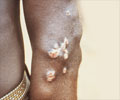
The alerts, based on an existing alert developed by the Centers for Disease Control, indicated whether or not infected people were labeled by the disease. The alerts also indicated the disease was transmissible or not transmissible between humans; had visible symptoms (open sores on arms and a wet, loud cough) or no visible symptoms; and was fatal, painful, and caused paranoid delusions, or was mild and easy to cure.The disease symptoms, labels associated with infected persons, perceptions of dangerousness, and responsibility comprise the four content cues in Smith's Model of Stigma Communication."These content cues can elicit responses such as disgust and anger," Smith said. "They can also shape the development of stigma and influence the likelihood that people will share a stigma message with others or endorse isolating and removing stigmatized people from community."The results, to be published in a forthcoming issue of Communication Monographs and available online now, showed that those communication choices, and how they made people think and feel, predicted how likely people were to endorse interventions.In addition, people were more likely to want to share the stigma message with others if the disease had visible symptoms rather than no visible symptoms."The visible symptom might suggest that infected persons are different," Smith said, "and this could facilitate social bonding among people spreading the rumor, even if infected persons are not considered a group in and of themselves." According to Smith, understanding how message choices influence the formation of stigma beliefs is critical."When stigmas form with infectious diseases, they can be barriers to health care access and provision in the short and long term," she said. "Understanding how communication choice in health messages influences the stigmatization process can give us the tools to write health alerts without creating or bolstering stigmas around infectious diseases. Once the stigmas are in place, we have few reliable ways to remove them."
Source-Eurekalert















